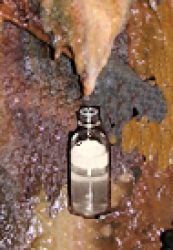
March Editorial
The world's oldest water

March Editorial
The world's oldest water
|
Water spends a lot of its time in rock - the mineral water offered by your local supermarket might have spent a few thousand years peculating through a mountain before ending up in a plastic bottle. But how long can water remain trapped in rock? The answer appears to be 'for a very, very long time'.
|
In an African gold mine in South Africa’s Witwatersrand Basin, an international group of researchers have found evidence for water which is 2.5 billion years old. This is definitely the oldest water found on Earth thus far. The scientists believe that it was originally trapped in the pockets within rocks near the earth’s surface. Once the rocks fractured and cracked this ancient water seeped from the pockets into the rock fractures. | |
|
Some crevices in the mine go 3 km into the earth, and the researchers were able to get samples of water from the bottom of these. Chemical analysis of the water samples revealed that the water has a composition unlike anything ever seen before. One of the leading researchers in the project is professor Barbara Sherwood Lollar (from the University of Toronto). She explains: "The chemical signatures we found don't match those of ocean water or waters higher up in the Witwatersrand Basin, whereas in most regions of the crust groundwater shows evidence of mixing with surface water". What was particularly interesting about the water composition which the researchers found was a very high level salinities along with an unusual neon (Ne) profile. Neon is an inert gas and can remain unchanged over very long periods because it rarely combines with other elements. On Earth, neon comes from three possible sources: the atmosphere, the molten mantle deep inside the Earth, and from the rocks in the crust. Neon can be present as one of three stable isotopes: 20Ne, 21Ne and 22Ne. Whereas 20Ne is mainly a primordial isotope (an isotope which has remained unchanged since before the Earth was formed), the other two isotopes can be formed as a result of a nuclear reaction - a process referred to as nucleogenic. The principal method by which 21Ne and 22Ne are generated is from 24Mg and 25Mg respectively, following capture of a neutron and the immediate emission of an alpha particle. The neutrons are mostly produced as a secondary nuclear reaction from alpha particles which can be derived from, for example, uranium-series decay chains. As a result uranium-rich rocks (for example granite) tend to have a lower 20Ne/22Ne ratio and higher 21Ne/22Ne ratio. This is exactly what the researchers found when analysing the water from the South African gold mine. The deep, more saline, fracture waters contain an enriched nucleogenic neon signature unlike any previously reported in crustal fluids. These samples show the highest 21Ne/22Ne ratios (0.160 ± 0.003) ever reported in groundwater. Fluid inclusions in these rocks yield even higher 21Ne/22Ne ratios between 0.219 and 0.515. This suggests that the Neon found in the water was produced in the surrounding rocks and has been seeping into the water for a very long time. Looking at the ratio of different neon isotypes allows the dating of those components. The researchers have shown that they have been there for about 2.7 billion years. Sherwood Lollar believes that the oldest water components date to the last time when the rocks were heated to extremely high temperatures by geological processes, something which happened around 2-2.7 billion years ago. At that time water containing dissolved neon, salts and other components was trapped in microscopic pockets in the rock. Further chemical analysis of this ancient water showed that the deepest, most saline fracture waters contain gases that are dominated by high concentrations of H2 gas, and CH4 (methane) and higher hydrocarbon gases (for example ethane, propane, butane, and pentane) with isotopic signatures attributed to abiogenic (produced from non-living matter) processes of water–rock reaction. The other interesting question is where this water come from originally. Unfortunately, this will be a difficult question to answer. Because the water has been there so long it has undergone so many alterations that is is almost impossible to determine the original source. In addition the extremely high salinities, much higher than in sea water (some 10x the level of sea water, in fact) has masked any evidence of the original source. This study will be published shortly in the Chemical Geology journal. Reference Johanna Lippmann-Pipke, Barbara S. Lollar, Samuel Niedermann, Nicole A. Stroncik, Rudolf Naumann, Esta van Heerden, Tullis C. Onstott. Neon identifies two billion year old fluid component in Kaapvaal Craton. Chemical Geology (2011) in press | |
| _______________________________ | ||||
| Home | | | Shopping | | | Database |
© Biscuit Software 2004-2015
All rights reserved